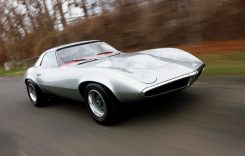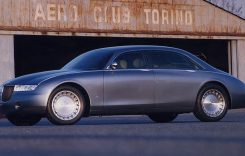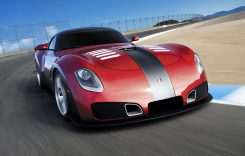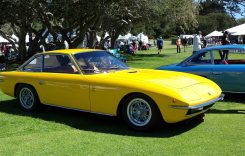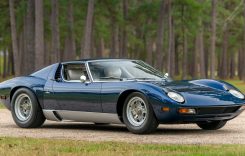
Is the Buell 1125CR Streetfighter perfection? We think so.
Despite having logged a fair number of miles on this bike during its German press introduction, I was still skeptical of how it would fair against both other machines—especially the Streetfighter. I mean, just look at the performance difference between their respective sportbike cousins. Only a fool would argue that the Buell 1125R is superior to the Ducati 1098 around the racetrack. Yet here, where the streets are these motorcycles’ primary mission, the Buell is simply too versatile of a motorcycle to bet against.
Beauty is in the eye of the beholder, though there isn’t a beholder on earth that can honestly say that either looks superior to the Duc. But is the Buell better looking than the Aprilia? Now, that’s a tough one. Two out of three testers thought so. The front end design and sculpted air scoops on each side of the bike make it look quite tough. The tail section is a bit conservative in design but still looks decent and we also really like the durable semi-gloss finish used on the frame, swingarm and wheels. The instrument display has a nice look to it though we wish the speed and gear position readouts were larger.
In fact, if Buell could fit a better looking exhaust system, clean up the right-hand side of the engine, do away with the archaic 1980s-style switchgear, improve the mirror stalks and ditch the Home Depot fasteners, we’d say that they might actually offer the Italian some real competition. Maybe one day Buell will understand that it’s the little things that count…



Lift it off its kickstand and it doesn’t feel particularly light. Slip into the seat, however, and you’ll notice how compact it feels. It’s like all of its 458-lb mass is carried about a foot off the ground, directly in the bike’s center. Normally the 1125CR comes with an extremely low-mounted, clubman-style handlebar designed for those seeking a café racer vibe. The machine we tested, however, featured the optional upright accessory handlebar. Grab them and you’ll be surprised by how relaxed and natural your upper body feels. It’s almost street-riding perfection. Just the way in which you’re positioned proves that Buell engineers spent some serious time dialing in the ergos. Lift your feet on the footpegs and your legs articulate into a sporty position, albeit to a lesser degree than both the Tuono and Streetfighter.
“Its ergonomics are so rad,” said Garcia. “Many would probably look at this thing and say that it looks stupid but Buell actually knew what they were doing when they designed this bike. Still, I think they need to fit a wider handlebar. It’s too narrow and kind of makes it feel like a mini-bike compared to the others.”
As mentioned before, the switchgear on the 1125CR is atrocious and definitely a weak link in an otherwise excellent package – it cheapens the overall feel of the machine quite a lot. Fire the engine and its 1125cc liquid-cooled V-Twin engine roars to life with a raised idle until its computer deems its reached operating temperature.
Like its competition, the 1125CR clutch offers a hydraulic assist ensuring superlight clutch lever pull. This works alright, but what we didn’t like is how the clutch engages at the end of its lever throw. Nonetheless, motoring away from a stop is made very easy for even a new rider due to its extremely low first gear.
Twist the throttle and the Buell’s engine feels surprisingly similar to the Ducati’s. It shakes like the Duc, it responds immediately when the gas is twisted like the Duc, and it even revs fast like the Duc. Initially, the bottom-end delivers a stout blast of power that rapidly transitions to an even more lustful mid-range. Keep on revving it, though, and it hits a wall, not delivering the same rush of horsepower as the Streetfighter. Glance at the dyno chart inside the photo gallery and see for yourself. The engine cranks out almost 100 horsepower from 8000 revs but from there it only increases by 20%, reaching its peak of 119.37 horsepower at its rev limit of 10,400 rpm. That’s it.
“The engine feels strong,” said Atlas. “It pulls well off the bottom and its mid-range is pretty decent, too. But once you spin it up towards the top the Buell doesn’t have anything on the Ducati. It stalls then you have to up-shift. It just lacks the top-end punch that makes the Streetfighter such a rush.”
The 1125CR’s ergonomics package is perfect both on the street and the racetrack.
Despite the fact that it features almost a whopping 17 peak horsepower deficiency, around Horsethief’s power zapping hills the 1125CR’s close-ratio gearbox and lower final drive gearing really help maximize the engine’s power. It was surprising how well it kept pace with the Streetfighter, especially up some of the steeper hills. But it comes does come at the price of fuel economy. Its shorter gearing causes the engine to spin a lot higher at everyday speeds, thereby sucking more fuel. It’s a good thing that it has the largest fuel capacity, because you’re going to need it.
The CR’s transmission moves through each gear more smoothly and with less restiance than the other bikes. And making things even better is the Hydraulic Vacuum Actuation (HVA) slipper-action clutch, which really works! Grab a couple downshifts, drop the left-hand lever, and let the clutch sort everything out. Although it’s not as good as the mechanical systems in other sportbikes we’ve tested, it does work very well. Another key difference is the 1125CR’s use of a belt final drive as opposed to the conventional chain setup on the Aprilia and Ducati. Not only does it look more tidy, it requires virtually no maintenance. We also removed the rear wheel to fit a different tire and discovered firsthand how easy it is to do.
One important performance effect of the belt-drive system is the direct connection the rider has between the throttle and the rear tire—which becomes especially apparent at the racetrack. Get on the gas and you can really feel the rear Pirelli tire dig into the pavement. Without a doubt it serves up the most rear end feel and allows you to comfortably light up the rear tire—can we say fun?
The Buell’s belt final drive gives the rider an enhanced level of feel to what’s happening at the business end of the Pirelli Diablo Corsa III rear tire.
The Buell’s aluminum chassis also impressed. Like the Aprilia it had a very rigid feel, but due to its sharper steering geometry and short wheelbase, it is easily the most agile bike in this comparison. Push on the bars the slightest bit and it drops into the corner easily and very predictably. Mid-corner it feels just as planted as the others, but as mentioned before with its belt final-drive, it gives the rider enhanced levels of feel, making corner exit perhaps the most thrilling aboard the Buell.
“This could be one of the most entertaining motorcycles I have ever ridden,” admits Garcia. “I felt like I was riding a Yamaha R6 with a Twin motor and some weight added to it. The bike’s corner stability was insane! There was nothing I didn’t like about the way it handled. It does everything perfect from entry to exit.”
“Best chassis of the group,” affirmed Atlas. “It just plain does everything right. It’s nimble, yet solid feeling at lean, and the suspension actually responds to adjustments. It does get some headshake here and there, but it’s always mild—not a big deal.”
As Atlas mentioned, the 1125CR has some propensity to headshake, so it would be nice if Buell fitted some type of steering damper. But as it sits now, for us, it isn’t a deal breaker. Like the Ducati, Showa suspension components are donned fore and aft. Not only are each of its three settings (spring preload, compression, and rebound damping) easy to adjust, its damping characteristics are perhaps a bit more sensitive to individual adjustments, making it possible for you to set up the bike for virtually any rider regardless of size or ability. Worth noting is how the rear shock absorber mounts directly between its twin-spar aluminum frame and swingarm, without a linkage. While this set-up works great at the track, on the streets it delivered a more jarring ride than the other bikes.
The Buell 1125CR’s stock exhaust system is a definite eye sore.
When it comes to braking, the 1125CR uses Buell’s funky ZTL2 braking technology. As opposed to a conventional twin rotor/caliper set-up, Buell uses a single rotor affixed to the perimeter of the front wheel. It’s controlled by a brick sized 8-piston Nissin caliper through a stainless-steel brake line. So does it work? Yes. Even though it lacks initial bite when the brake lever is touched, pull back harder and the brake slows down the front wheel at a level of force on par with the other bikes. When doing so the rider is greeted with an enhanced level of braking sensation. Thus, if you want to get the most out of the Buell’s brakes, you’re going to have to use them aggressively.
